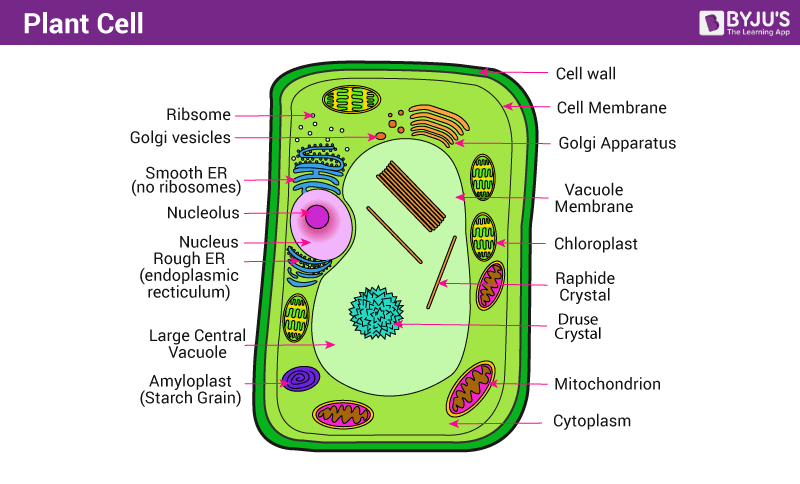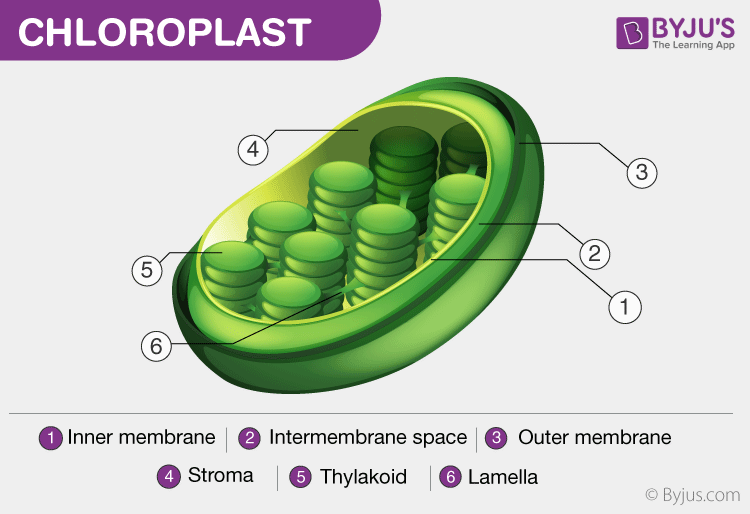What Is The Function Of The Vacuole In An Animal Cell
The cell is the basic unit of measurement of life in all organisms. Similar humans and animals, plants are also composed of several cells. The plant cell is surrounded past a cell wall which is involved in providing shape to the constitute cell. Apart from the cell wall, at that place are other organelles that are associated with different cellular activities.
Allow us have a detailed expect at the plant prison cell, its structure and functions of dissimilar institute cell organelles.
Plant Cell Definition
"Plant cells are eukaryotic cells with a true nucleus along with specialized structures called organelles that carry out sure specific functions."
What is a Establish Cell?
Plant cells are eukaryotic cells that vary in several fundamental factors from other eukaryotic organisms. Both plant and animal cells contain nucleus along with similar organelles. One of the distinctive aspects of a plant cell is the presence of a prison cell wall exterior the prison cell membrane.
Read more: Cells
Constitute Cell Diagram
The plant prison cell is rectangular and insufficiently larger than the brute prison cell. Even though plant and fauna cells are eukaryotic and share a few jail cell organelles, constitute cells are quite distinct when compared to animal cells as they perform different functions. Some of these differences can exist clearly understood when the cells are examined under an electron microscope.
Also Read:Cellulose in Digestion

Plant Cell Diagram showing different cell organelles
Establish Cell Structure
Just like different organs inside the body, plant cell construction includes various components known as cell organelles that perform different functions to sustain itself. These organelles include:
Cell Wall
It is a rigid layer which is composed of cellulose, glycoproteins, lignin, pectin and hemicellulose. Information technology is located outside the cell membrane. It comprises proteins, polysaccharides and cellulose.
The master role of the prison cell wall is to protect and provide structural support to the cell. The plant jail cell wall is besides involved in protecting the cell against mechanical stress and to provide course and structure to the cell. Information technology also filters the molecules passing in and out of the cell.
The formation of the cell wall is guided by microtubules. It consists of three layers, namely, primary, secondary and the centre lamella. The chief prison cell wall is formed by cellulose laid downwards by enzymes.
Also Read:Cell Wall
Cell membrane
It is the semi-permeable membrane that is present within the cell wall. It is composed of a thin layer of poly peptide and fat.
The cell membrane plays an important role in regulating the entry and go out of specific substances within the cell.
For example, cell membrane keeps toxins from entering inside, while nutrients and essential minerals are transported across.
Besides Read:Cell Wall and Prison cell Membrane
Nucleus
The nucleus is a membrane-leap structure that is nowadays simply in eukaryotic cells. The vital role of a nucleus is to shop DNA or hereditary information required for cell segmentation, metabolism and growth.
- Nucleolus: It articles prison cell's protein-producing structures and ribosomes.
- Nucleopore: Nuclear membrane is perforated with holes called nucleopore that allows proteins and nucleic acids to pass through.
Explore more:The Nucleus
Plastids
They are membrane-bound organelles that accept their ain DNA. They are necessary to store starch, to carry out the procedure of photosynthesis. It is also used in the synthesis of many molecules, which course the building blocks of the cell. Some of the vital types of plastids and their functions are stated below:
Leucoplasts
They are establish in not-photosynthetic tissues of plants. They are used for the storage of protein, lipid and starch.
Chloroplasts
It is an elongated organelle enclosed by phospholipid membrane. The chloroplast is shaped similar a disc and the stroma is the fluid within the chloroplast that comprises a circular Dna. Each chloroplast contains a dark-green coloured pigment called chlorophyll required for the process of photosynthesis. The chlorophyll absorbs light free energy from the sun and uses it to transform carbon dioxide and water into glucose.
Also Read:Chloroplasts

Chromoplasts
They are heterogeneous, coloured plastid which is responsible for pigment synthesis and for storage in photosynthetic eukaryotic organisms. Chromoplasts accept red, orange and yellow coloured pigments which provide colour to all ripe fruits and flowers.
Central Vacuole
It occupies around 30% of the cell'due south volume in a mature plant prison cell. Tonoplast is a membrane that surrounds central vacuole. The vital role of central vacuole apart from storage is to sustain turgid pressure level against the prison cell wall. The primal vacuole consists of cell sap. It is a mixture of salts, enzymes and other substances.
Also read:Vacuoles
Golgi Apparatus
They are found in all eukaryotic cells which are involved in distributing synthesized macromolecules to various parts of the jail cell.
Explore more:Golgi Apparatus
Ribosomes
They are the smallest membrane-bound organelles which comprise RNA and poly peptide. They are the sites for protein synthesis, hence, as well referred to every bit the protein factories of the cell.
Explore more:Ribosomes
Mitochondria
They are the double-membraned organelles found in the cytoplasm of all eukaryotic cells. They provide energy past breaking down carbohydrate and sugar molecules, hence they are likewise referred to as the "Powerhouse of the cell."
Explore more than:Mitochondria
Lysosome
Lysosomes are called suicidal bags as they hold digestive enzymes in an enclosed membrane. They perform the part of cellular waste disposal by digesting worn-out organelles, nutrient particles and foreign bodies in the cell.
Besides read:Lysosomes
Establish Cell Types
Cells of a matured and higher plant go specialized to perform sure vital functions that are essential for their survival. Few plant cells are involved in the transportation of nutrients and water, while others for storing food.
The specialized plant cells include parenchyma cells, sclerenchyma cells, collenchyma cells, xylem cells and phloem cells.
Following are some of the dissimilar types of constitute cells:
Collenchyma Cells
They are hard or rigid cells, which play a primary office in providing support to the plants when there is restraining growth in a plant due to lack of hardening agent in primary walls.
Sclerenchyma Cells
These cells are more rigid compared to collenchyma cells and this is because of the presence of a hardening amanuensis. These cells are usually found in all plant roots and mainly involved in providing support to the plants.
Parenchyma Cells
Parenchyma cells play a significant role in all plants. They are the living cells of plants, which are involved in the product of leaves. They are likewise involved in theexchange of gases, production of food, storage of organic products and jail cell metabolism. These cells are typically more than flexible than others because they are thinner.
Xylem Cells
Xylem cells are the transport cells in vascular plants. They assist in the transport of water and minerals from the roots to the leaves and other parts of the plants.
Phloem Cells
Phloem cells are other transport cells in vascular plants. They transport food prepared by the leaves to different parts of the plants.
Refer more: Constitute Tissue System
Plant Cell Functions
Found cells are the building blocks of plants. Photosynthesis is the major function performed by plant cells.
Photosynthesis occurs in the chloroplasts of the plant cell. It is the process of preparing food past the plants, by utilizing sunlight, carbon dioxide and water. Energy is produced in the form of ATP in the process.
A few plant cells aid in the transport of water and nutrients from the roots and leaves to different parts of the plants.
Also read:Golgi Appliance
To more than about a constitute cell, its definition, structure, diagram, types and functions, keep visiting BYJU'S Biology website or download BYJU'Due south app for further reference.
Frequently Asked Questions
What is a establish cell?
A plant cell is a eukaryotic cell that contains a true nucleus and certain organelles to perform specific functions. However, some of the organelles nowadays in plant cells are different from other eukaryotic cells.
What are the different types of institute cells?
The different types of plant cells include- collenchyma, sclerenchyma, parenchyma, xylem and phloem.
Which organelles are found but in establish cells?
The organelles found only in plant cells include- chloroplast, prison cell wall, plastids, and a big central vacuole. The chloroplasts contain a light-green paint chlorophyll that is responsible for the process of photosynthesis.
What is the composition of a found cell wall?
The cell wall of a constitute is made up of cellulose. Cellulose is a long, linear polymer of several glucose molecules.
Where does photosynthesis occur in found cells?
Photosynthesis occurs inside the chloroplast of the plant cells. Chloroplast consists of a light-green pigment called chlorophyll. The light reactions occur inside the thylakoids of the chloroplast where the chlorophyll pigment is constitute.
Source: https://byjus.com/biology/plant-cell/
Posted by: rommelcouldic.blogspot.com

0 Response to "What Is The Function Of The Vacuole In An Animal Cell"
Post a Comment